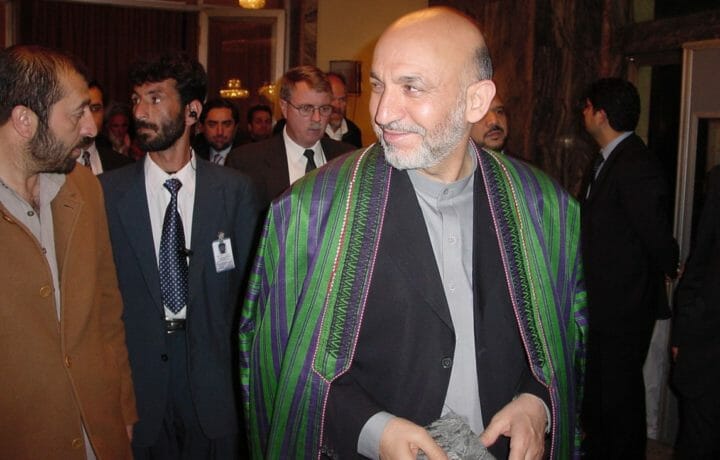Hundreds of dedicated diplomats, intelligence and military officers from numerous nations have been helping to shepherd the Afghan and U.S. governments towards the agreements signed February 29. I have been working on it since May 2009 and wanted to explain what the US-Afghan and US-Taliban agreements mean with my context of knowing the original plan devised over a decade ago by the Afghan government.
two critical events in the Afghanistan peace agreement
1. A Commitment to Long-Term Cooperation
Most importantly the U.S. and NATO started the day committing to long-term Afghan security cooperation.
This emphasized the international recognition of the legitimacy of the Islamic Republic of Afghanistan and security cooperation with it, and was also a moment for Afghans to show unity as most of the major national and provincial leaders were present, including four women visible on the main stage. Now the Afghans, led by their government, must seize the peace talks and create a durable peace.
2. The Taliban Agreed they Could Not Defeat the U.S or Afghan Forces
The U.S. signed a document (the Taliban surrender agreement) with the Taliban movement that acknowledged that the Taliban could not defeat the U.S. or the Afghan National Defense and Security Forces (ANDSF) militarily and that the Taliban are ready to engage in direct talks with the legitimate Afghan government. That is something the Taliban vowed never to do when we first broached talks in 2009.
This shows that Taliban and its main supporter, the Pakistani government, were ready to move from military warfare to politics to settle their issues with the Afghan government. The agreement also ensures that the Taliban break ties with terrorists, and sets up direct talks between the Afghan government and the Taliban. It goes further, requiring substantive progress. The agreement sets up a chance for a permanent ceasefire for all of Afghanistan.
The U.S. goal since 2009 was to follow the Afghan government’s lead, as asked by President Karzai, to get the Afghan government and the Taliban movement into direct peace talks. That goal has now been met due to the military pressure of the NATO coalition and most importantly the ANDSF. There was no other U.S. goal that mattered more. These always had to be Afghan-led and Afghan-owned peace talks. Now the Afghans own the peace process and the US can mediate as requested. We are partners and will continue to be.
The agreement conditionally sets up a time table for the withdrawal of non-Afghan security forces from the country. But stipulates that if the Taliban cheat, the withdrawal does not go forward and the cease fire ends so the ANDSF and their partners can hunt down the Taliban.
The agreement was brilliantly written by the U.S. to negate the existence and recognition by anyone of the so-called “Islamic Emirate.” It places those words on every entry of the agreement so that the Taliban can’t misuse the document for propaganda. It exposes their false belief that they are a government in exile. The agreement was not meant to cover women’s rights, make changes to the Afghan constitution, prescribe the type of government the Afghan people will develop in their future peace talks or anything else. If the U.S. tried to do that, they would be speaking for the Afghan people and that is not their place. The Afghan government will now figure out all those things and the US will support their decisions.
The U.S.-Taliban agreement stipulates that the U.S. and coalition would remove all combat troops, trainers, and advisors over the next 14 months. That gives the ANDSF 14 months to prepare to fill the gap left by foreign trainers and advisors. In that 14 months many things will/may occur:
- The Taliban and other entities will decrease their violence upon Afghanistan, possibly to zero.
- Afghan SOF will be able to focus on becoming advisors and trainers for the ANA conventional units and the MOI and NDS forces.
- Afghan security forces will be converting their missions from force-on-force attacks against the Taliban towards peacekeeping, mediation of local issues, law and order policing, and protecting reintegrating Taliban fighters, internally displaced people and returning Afghan refugees from the region.
- If the Taliban do not decrease violence, or restart violence, the foreign forces will not leave or could return to assist the ANDSF in any way the Afghan government asks them to.
- The Afghans may decide in those 14 months, after the peace with the Taliban is established, that they do want foreign forces based in the country to help with peace enforcement duties. If asked, many NATO coalition nations would likely stay on to help their ANDSF partners.
The future will be difficult, but Afghans are up to the challenge. Afghans will build peace, or the U.S. and their coalition partners will stay to beat down the spoilers until peace is achieved, if the Taliban break the agreement in the next 14 months.
Taliban are not taking over the government. To do so they would need military strength that they do not have. Since 2001 they have never threatened the capital, a major city, or a province. They are spent militarily and their fighters will go home now. Their fighters have already started to surrender for reintegration.
Taliban fighters will not be sent straight to the military or police. Most of them are not suitable for peace enforcement duties. They will get other jobs, get educated, and make their own path forward as Afghan citizens. The ANDSF is large enough already.
See Part 2 of this series to find out the story behind how the Afghan government got the Taliban to enter peace talks.




